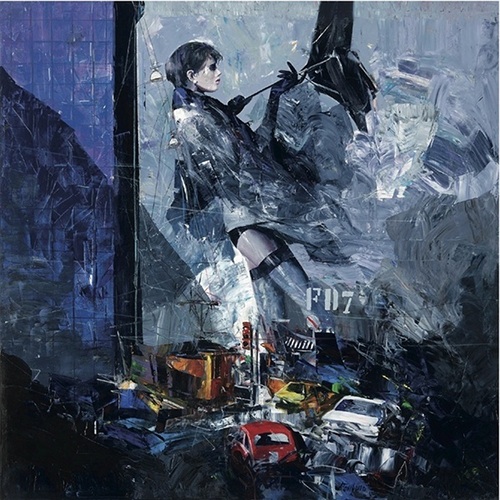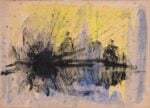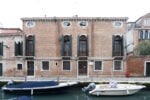Antonio Tamburro – La pittura

La mostra vuole essere un omaggio alla città di Perugia dove il maestro ha vissuto e lavorato per venticinque anni e dove ritorna ad esporre dopo molti anni.
Comunicato stampa
A Perugia il 3 febbraio 2012 inaugura la mostra antologica del maestro Antonio Tamburro “La pittura di Antonio Tamburro tra passato e presente “ presso il centro servizi camerali Galeazzo Alessi di Via Mazzini.
La mostra è patrocinata dalla Banca di Mantignana e di Perugia, dall’INPS, dalla Regione Umbra, dalla Provincia e dal Comune di Perugia, in collaborazione con la 6° Senso Art Gallery di Roma. La mostra vuole essere un omaggio alla città di Perugia dove il maestro ha vissuto e lavorato per venticinque anni e dove ritorna ad esporre dopo molti anni. Le trentacinque opere esposte ripercorrono la carriera artistica del maestro Tamburro dagli anni ’80 al 2003, fino ai dipinti più recenti. I temi vanno dai quadri ad olio sulle periferie, l’ambiente, le spiagge, i caffè, fino a quelli più recenti delle metropoli, dei volti femminili, delle macchine, degli ombrelli e degli strumenti musicali realizzati ad acrilico. La mostra proseguirà fino al 29 febbraio 2012.
In Perugia on February 3, 2012 opens the retrospective of the master Antonio Tamburro “The painting of Antonio Tamburro between past and present“ at the Center Chamber of Galeazzo Alessi in Via Mazzini.
The exhibition is sponsored by the Bank of Mantignana and Perugia, the INPS, the Region of Umbria, the Province and the Municipality of Perugia, in collaboration with the 6° Senso Art Gallery in Rome. The exhibition is a tribute to the city of Perugia, where the master lived and worked for twenty-five years end where he returns to exhibit after many years. The thirty-five works on display trace the artistic career of the master Antonio Tamburro, from the ‘80s to 2003, up to more recent paintings. The themes range from oil paintings on the outskirts, the environment, the beaches, the cafes, to the more recent of the metropolis, the female faces, the cars, the umbrellas and the musical instruments in acrylic. The exhibition will run until February 29, 2012.
Antonio Tamburro è nato a Isernia nel 1948. La sua prima personale risale al 1972, presso il Palazzo Comunale di Perugia. In questi quadri c’è un richiamo alle origini, con un forte e violento cromatismo di stampo espressionista. Nel 1974 espone a Milano alla galleria “ La Porta “. E’ anche l’anno in cui comincia ad interessarsi alle problematiche sociali, in particolare all’abbandono e alla solitudine dei malati di mente, su ispirazione di reportage realistici.
Nel 1979 alcune sue opere vengono pubblicate “Arte in Umbria” edizioni Siglarte. Le sue opere cominciano ad essere pubblicate su varie riviste d’arte . Viene anche chiamato ad insegnare alla scuola d’arte di Spoleto che poi lascerà nel 1981 per dedicarsi esclusivamente alla pittura, nonostante l’incarico in ruolo a tempo indeterminato. Nel 1984 partecipa alla mostra “ Itinerari, ricerca e misteri nell’arte ”, Artisti umbri e contemporanei, al Gianicolo Centro d’Arte insieme a Burri, De Gregorio, Rambaldi ed altri. Nel 1989 esce sulla rivista “ Arte Mondadori “ un servizio dedicato al tema delle periferie e la stessa mondatori pubblicherà un catalogo con un testo critico di Dario Micacchi e dell’artista Alberto Sughi.
Nel 1991 tiene una personale intitolata " Le Giuliette di Tamburo” e allestita nei suggestivi spazi della Casa di Giulietta a Verona. Il 1991 è anche l’anno in cui comincia a frequentare l’ambiente artistico romano. Conosce artisti quali Calabria, Sughi, Vespignani, Attardi e il fotografo Pino Settanni che lo inserisce nel suo libro di fotografie “ La memoria e le Immagini ”, dedicato agli artisti e ai personaggi del cinema e della cultura. Nel 1999 tiene la personale alla Galleria Padua Art di Padova. Nel 2000 Partecipa ad Art Miami, con un catalogo curato da Raffaele Nigro. Nel 2001 esce un servizio sulla rivista “ ArteIn “ con un testo critico di Paolo Rizzi. Nel 2002 esce sul mensile “ Arte Mondatori “ un redazionale sui protagonisti della pittura contemporanea, intitolato “ Il solitario della pittura “.
Nel 2003 in occasione della Notte Bianca di Roma, partecipa alla collettiva presso la Galleria Michelangelo, insieme ad Attardi, Benaglia, Calabria, Possenti, Sughi, ed inoltre all’A.R.G.A.M, Primaverile Romana sul tema “ Mitologia dell’immaginazione ”. Questo sarà l’anno più ricco di eventi, infatti le mostre personali si susseguono sia in Italia che all’estero: la mostra personale presso la Galleria Barbara Ruez di Monaco e nella Galleria di Augsburg, la personale presso la Sala Segantini in Svizzera nella sede della Fondazione. Nel 2006 l’artista sarà protagonista di una esposizione nella sede di Confartigianato a Prato, mentre il quotidiano “ La Gazzetta dello Sport “ gli commissiona la realizzazione del logo della Maglia Rosa, simbolo del novantesimo Giro D’Italia. Nel 2008 espone con una personale in Austria alla Galleria Schlossparz, mentre nel marzo successivo si onorerà di donare al Santo Padre, previa udienza, l’opera “ Ritratto di Papa Benedetto XVI “ da lui realizzata. Nel 2008 realizza anche il manifesto per i Campionati del mondo di ciclismo di Varese ed espone con una personale nella Galleria d'Arte 6° Senso di Roma, dal titolo “Il ciclismo e i suoi protagonisti”. Nel 2009 il Comando generale della Guarda di Finanza ha affidato a Tamburro l’incarico di illustrare il calendario storico del Corpo. Ad Aprile del 2009 partecipa alla collettiva "Artisti italiani in Russia" presso la galleria Svetlana Serebtyakova di San Pietroburgo. A giugno del 2009 partecipa all'esposizione d'arte Eternologie, in occasione dei Giochi del Mediterraneo di Pescara. Le sue opere dedicate al ciclismo vengono esposte nella sede della Casa Italia, quartier generale degli azzurri e del CONI. Il 10 dicembre 2009 inaugura a Palazzo Venezia di Roma la sua prima mostra antologica "Il senso del tempo. Opere dal 1980 al 2009. Il 6 agosto 2010 inaugura a St.Moritz una personale dedicata prevalentemente alle tematiche del Jazz che si inserisce nel contesto del Festival del Jazz di St.Moritz. Il 10 settembre del 2010 inaugura una mostra alla Galleria der Pinakothek der Moderne di Monaco di Baviera. Il 16 settembre 2010 inaugura una mostra dal titolo “Le metropoli dell’indifferenza” alla Galleria Primo Piano di Venezia, che verrà spostata subito dopo alla Galleria Miniaci di Milano. L’11 novembre inaugura una doppia personale insieme al figlio Marco al Museo d’Arte Moderna Vittoria Colonna di Pescara dal titolo: Antonio e Marco Tamburro “Dal colore al bianco e nero”. Dal 20 gennaio al 20 febbraio 2011 tiene una personale alla Galleria d’Arte 6° Senso di Roma, dove espone una serie di opere inedite sul tema degli ombrelli. Dal 14 al 28 marzo 2011 espone con una personale a San Pietroburgo. Dall’ 8 al 29 maggio 2011 tiene una mostra nell’ex chiesa di San Domenico a Ravenna: “Ravenna.. e il Giro d’Italia”, dedicata al mondo del ciclismo e ai grandi del ciclismo italiano, da Bartali e Coppi a Pantani. Il 14 ottobre 2011 tiene una personale a Berlino alla Galerie Lacke Farben dal titolo “Spuren und Farben der Stadt” - “Graffi e colori di una città”. In mostra sono esposti dipinti che vanno dall’ultimo tema degli ombrelli fino alle metropoli e alle donne solitarie nei caffè.
Antonio Tamburro was born in Isernia in 1948. After the studies at the School of Art, in 1966 he attended the Academy of Belle Arti of Naples, where he met the Professor Giovanni Brancaccio. In 1968, after studying in Naples and attending a course of painting at the Academy of Fine Arts in Rome at that time directed by Prof.Franco Gentilini, due to the amount of other academic lessons in relation to painting classes he decided to leave the academy. During the same year, he helped achieve many paintings for the designer Filippo Senerchia including those of the Flavio Vespasiano Theatre in Rieti. In 1971 he restored the missing parts of the frescoes realised by the painter Trevisonno, in the church of S. Anna in Cantalupo del Sannio(IS). In same year he opened his first solo exhibition at the gallery “Il Carboncino” in Campobasso where he started to meet the emerging artists of that period. In 1972 he moved to Perugia where he exposed his works in a solo exhibition at the Palazzo Comunale (Town Hall). In these paintings there is an allusion of his origins, with a strong and violent chromatism typical of impressionism. In Perugia he joined the cultural group “Il Cenacolo” and took part in a group exhibition of artists from Umbria and then in a group exhibition at the gallery “Il Cenacolo” in Perugia. In 1974 he started up an exhibition in Milan at “La Porta” gallery . It was also the year in which he began to deal with social issues, particularly the loneliness and abandonment of the brainsick people, inspired by television and media coverage of the problem. These themes were proposed again in 1977 in a exhibition at the Cecchini gallery in Perugia where the series - "Sick measures"- was exposed for the first time, but started in 1974. The exhibition shocking for some aspects, was not appreciated by critics and audience. In 1975 another exhibition was held at the at the Palazzo dei Priori in Perugia.
In 1976 an exhibition in Assisi exposed the sanguine drawings at the Ghironda gallery. In 1977 he had a personal exhibition at "Galleria Malatestiana" in Rimini. In 1978 at Villa Olmo, through the prize Lario Cadorago, he met a great patron of art: Albo Pollici, who will become his friend and supporter. In 1979 some of his works were published in the magazine “Arte in Umbria” edited by Siglarte. His works began to be published in various art magazines. Up to 1981 he was also asked to teach at the school of art of Spoleto but thereafter he will devote himself exclusively to painting. In 1981 was published an article in a national magazine "Il Nostro Tempo" and in 1982 he achieved work on "Arte e Ferrovia" (Art and Railway), that now is in the museum of Ferrovie dello Stato di Pietrasanta. This is also the year of the solo exhibition at “Emilia” gallery in Modena, which led him to open a new theme on the environmental pollution. In conjunction with these exhibitions he published is first catalogue with a presentation by Giorgio Grando. This theme will be repeated in subsequent exhibitions, like the one in 1983, held in the Sala del Grifo e del Leone at Palazzo Comunale (Town Hall) of Perugia. In 1982 he took part in a group exhibition at the Rocca Paolina in Perugia under the title "The cooperation and society in crisis" and in this year he also cooperated in a group exhibition “Meeting with five painters” organized by the Municipality of Spilimberto. In 1983 he took part in a group collection in the Tendostruttura of Todi and at the Marina Prize in Ravenna he met Domenico Purificato, Gastone Freddo and Remo Brindisi. In 1984 he participated at the exhibition titled "Itineraries, Research and Mysteries with contemporary artists from Umbria” at the Gianicolo Centro d’Arte together with Burri, De Gregorio, Rambaldi and others. In the same year he realised a monumental masterpiece for the armour hall of the school Three F Italia, representing "Seneca and his students" with the selfportrait of the artist. In recent years he had relationship with the Mantignana Community, a village close to Perugia with whom he will always have a strong human and artistic bond. Mantignana implemented different projects, a large part of which was the big size painting about the cooperation between arts and crafts for the Cassa Rurale e Artigiana, located at the headquarters of the bank management. In 1985 he achieved a fresco in the inner facade of Santa Maria Assunta depicting the crucifixion, the coronation of the Virgin and scenes of paradise. In 1989 on the magazine "Arte Mondadori" was published an article dedicated to the theme of suburbs and the same Mondadori published an art book with a critical text by Dario Micacchi and of the artist Alberto Sughi. In 1990 he was commissioned by Fondazione Spadolini, Pian dei Giullari, Firenze – the portrait of Senator Giovanni Spadolini. In 1991, he held a personal exhibition entitled "The Juliets of Tamburro" set in the beautiful spaces of the House of Juliet in Verona. In 1991 he also started to attend the Roman artistic environment flourished. He knew artists such as Calabria, Sughi, Vespignani, Attardi and the photographer Settanni put in his book of photographs "TheMemory and the Image",dedicated to artists and film personalities and other cultural figures. In 1993 in the Monumental Complex “Le Zitelle” in Venice together with the artist Nag Arnoldi exhibited some works and participated as part of the jury in the review "La modella in arte". In 1994 he opened a solo exhibition in the Transit Gallery of Bergamo and at the gallery "Marzabotto Arte" of Marzabotto and some of his works were published in the magazine "Di Cronaca e Critica – Viaggio nel Mondo delle Arti Visive dal Fascismo ad Oggi." In 1995 the exhibition was held at “Il Torchio” gallery, Milan. 1996 was the year in which the artist opened up the American Market and thanks to his friend, Mario Mognetti, the tireless and capable director of the Galleria Ghelfi di Piazza Erbe, an exhibition was set up in Toronto at the "Teodora Art Gallery."In 1999 he exposed his works at the Padua Art Gallery of Padova. In 2000 he joined Art Miami, with an art book edited by Raffaele Nigro. In 2001, a feature could be found in the journal "ArteIn" with a critical text of Paolo Rizzi. In 2002,"Arte Mondadori" published an editorial on the protagonists of contemporary painting, entitled "The solitary painting." In 2003 at the White Night in Rome, he participated in the group exhibition at the Galleria Michelangelo along with Attardi, Benaglia, Calabria, Possenti and Sughi. He also participated atvARGAM, the Roman Spring on "Mythology of Imagination." In the same year he exhibited at the "Studio4" gallery of Molfetta and at the Padua Art Gallery. In 2003 the Michelangelo Gallery presented an exhibition of his works from 1980 onwards. Abroad he proudly presented a solo exhibition at the Gallery Barbara Ruez of Monaco and the Augsburg gallery, an exhibition at the Segantini Hall in Switzerland at the headquarters of the Foundation. In 2005 the Michelangelo Gallery and traditional Municipal Culture Napoli helded a prestigious exhibition edited by Fabio Cozzi in the set of Castel dell'Ovo. The event was an opportunity to present the monograph published by Giorgio Mondadori with a text by Gabriele Simongini. Simultaneously the same monograph was presented by the Bocca Library of Milan. In 2006 he exhibited some works either at the Galleria Piazza di Verona or at the Art Gallery of Padua Padova with an opening exhibition at the "Bocca di Bacco" Gallery in Berlin. Even in 2006 he was the principal artist at an exhibition at the headquarters of Confartigianato Prato, while the daily newspaper "La Gazzetta dello Sport" commissioned his logo for the Pink Jersey, the symbol of the ninetieth Giro D'Italia.
In 2008 he exhibited works of art in Austria at the Schlossparz Gallery and in March of the following year he was honored to donate his work entitled "Portrait of Pope Benedict XVI" to the pope and enjoy a hearing with the aforementioned. In May 2008 the Editorial Body for the Body Guard of the Finance commissioned the construction of the works that will be the illustration of the Calendar Town Guardia di Finanza of 2009. In 2008 he achieved the manifesto for the Cycling World Championships in Varese and opened an exhibition in the 6° Senso Art Gallery, entitled "Scratch in Time". In May 2009 sets out with a dedicated staff cycling: “Cycling and its players” at 6° Senso Art Gallery. In April of 2009 participates in the collective "Italian Artists in Russia" at the gallery Svetlana Serebtyakova in St. Petersburg. In June of 2009 he participated at the art exhibition “Eternologie”, during the Mediterranean Games in Pescara. His works are devoted to cycling exhibited in the headquarters of the House Italy, headquarters of the blue and the CONI. On December 10, 2009 Grand Opening at the Palazzo Venezia in Rome his first retrospective exhibition "The sense of time. Works from 1980 to 2009”. In August 6, 2010 he opened in St. Moritz a solo exhibition dedicated mostly to jazz themes in the contest of the Jazz Festival of St. Moritz. In September 10, 2010 he started up an exhibition in der Pinakothek der Moderne gallery of Monaco di Baviera. In september 16, 2010 he opened an exhibition titled “the Cities of Indifference” at Primo Piano Gallery in Venice, which will be moved to Miniaci Gallery in Milano. In November 11, 2010 he opened a double solo together with his son Marco at the Museo d’Arte Moderna Vittoria Colonna in Pescara with the title: “Antonio and Marco Tamburro – From Colour to Black and White”. From January 20 to February 20, 2011 makes a solo show at 6° Senso Art Gallery in Rome, where he exhibits a series of new works on the theme of umbrellas. From 14 to 28 of March, 2011 is his personal exhibition in St. Petersburg. From 8 to 29 of May 2011 makes an exhibition in the former church of San Domenico in Ravenna: “Ravenna…and the Tour of Italy”, dedicated to the world of bicycling and the most important Italian bicyclists, from Bartali and Coppi to Pantani. On October 14, 2011 has a solo show in Berlin at the Galerie Lacke Farben, entitled “Spuren und Farben der Stadt” - “Scratches and Colours of a city”. Paintings ranging from the latest subject of the umbrellas to the metropolis and the lonely women in the cafes are presented in the exhibition.



